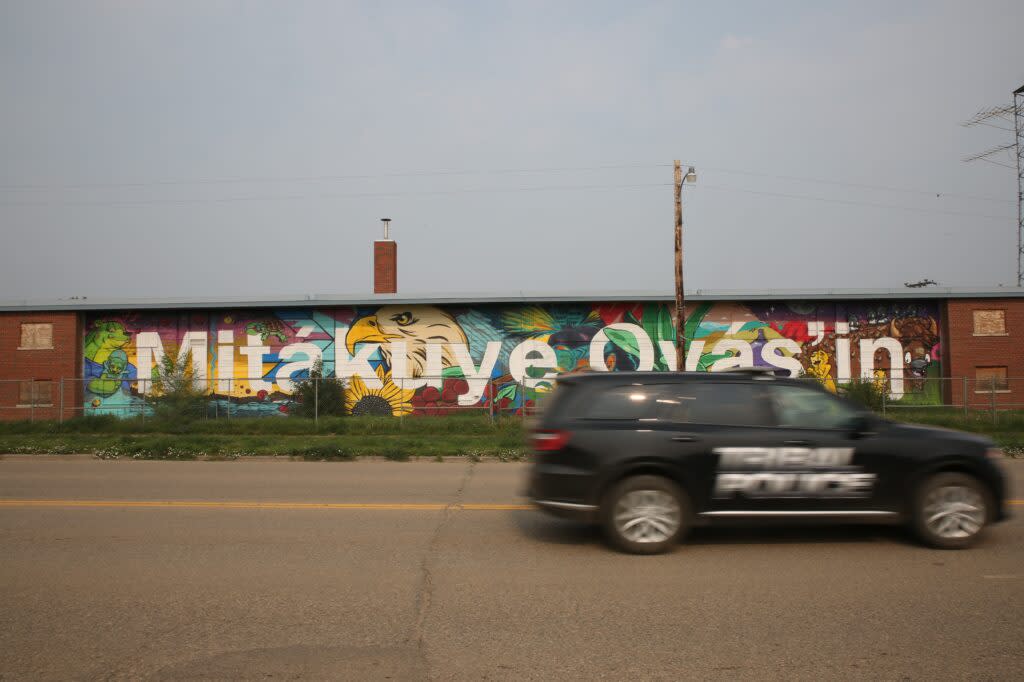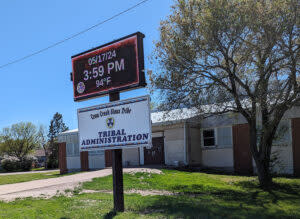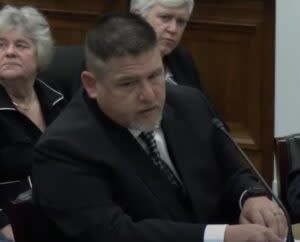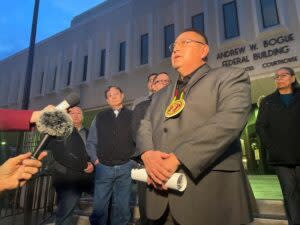Noem’s ‘banish the cartels’ obscures statewide drug problem, tribal leaders say

- Oops!Something went wrong.Please try again later.
A tribal police car drives past a boarded up apartment complex on Main Street of Eagle Butte, South Dakota on the Cheyenne River Indian Reservation. (Makenzie Huber, South Dakota Searchlight)
EDITOR’S NOTE: This story is the second in a series exploring the influence of drug cartels in South Dakota, on and off the state’s reservations. The first story can be found at this link.
For months, Gov. Kristi Noem has stoked controversy by calling on tribal leaders to “banish the cartels.”
But Noem has never mentioned 18-pound methamphetamine shipments from Arizona to Trent, population 218, by way of Mexico.
She hasn’t publicly spoken about the Mexican nationals convicted recently for their roles in a locally led, Sioux Falls-based drug ring, or in a similar, larger ring investigated in Rapid City.
Nor has she talked about the California prison inmate who used an illegal cell phone to orchestrate the sale of more than 200 pounds of meth and 80,000 fentanyl pills – all cartel-sourced – in South Dakota.
“Nobody is safe,” said Ron Parsons, who served as U.S. attorney for the District of South Dakota under former President Donald Trump. “The cartels are everywhere. They have distribution networks everywhere, and the end distributors are not from Mexico. They’re usually from the local communities. It’s in Sioux Falls, it’s in Rapid City, it’s in Aberdeen, it’s in the rural areas, and it’s in the tribal areas.”
Save a handful of mentions of cartel narcotics as a statewide issue, Noem has focused her comments about drug cartels on tribal areas, painting the state’s reservations as lawless safe havens for criminals, made so by federal inaction at the U.S.-Mexico border and tribal corruption.
Tribal leaders have described feeling targeted and scapegoated for a statewide problem, and the monthslong episode scratched a generational wound. Tribes have struggled for decades to secure public safety dollars but remain underfunded, their leaders say, even as treaties obligate the federal government to provide adequate resources.
Tribal areas do have vulnerabilities other parts of the state do not, such as fewer law enforcement officers, jurisdictional challenges that can stop tribal police from arresting non-Natives, and high rates of poverty and drug abuse.
But Noem’s comments, including those accusing tribal leadership of “personally benefiting” from cartels, have soured relations with the state’s nine Native nations. Leaders from all nine have voted to ban Noem from their lands.
Tribal leaders have rejected allegations that tribal council members are benefitting from cartel activity. Lower Brule Tribal Chair Clyde Estes told South Dakota Searchlight that if there’s evidence of collusion between drug dealers and tribal leaders, that evidence ought to be given to law enforcement so those leaders can be held accountable.
Other leaders have called out the governor for using stereotypes to build a narrative for political purposes.
Standing Rock Sioux Tribal Chairwoman Janet Alkire, in an April press release, called Noem’s remarks “a sad reflection of her fear-based politics that do nothing to bring people together and solve problems.”
Rosebud Sioux Tribal Chairman Scott Herman said in a March statement that Noem’s remarks “were made from ignorance and with the intention to fuel a racially based and discriminatory narrative towards the Native people of South Dakota.”
Crow Creek leader: ‘My people are targeted’
Some tribal leaders have long acknowledged a flow of drugs from cartels or affiliates to their communities and have decried a dearth of federal funding for tribal police. They’ve pointed out that the drugs come to reservations from larger cities.
Others have denied any direct cartel presence, though they acknowledge the impact of illegal narcotics.
Peter Lengkeek, chairman of the Crow Creek Sioux Tribe, said Noem’s comments carry a real-world impact for Native Americans, as they paint tribal citizens who already face racism as agents of crime based solely on their address.
“She’s really created a dangerous environment for us by putting that out there, because now my people are targeted when we leave the reservation,” Lengkeek said. “Targeted by police, targeted by Trumpers, and targeted by South Dakotans who are blaming us now for the fentanyl issue here in the state of South Dakota.”

For Chase Iron Eyes, director of the Lakota People’s Law Project, the trouble with the governor’s focus on tribes isn’t about whether communities like his are at risk.
It’s about whether pointing fingers hinders the kind of cooperation necessary to address the problem.
“I agree in substance with what Kristi Noem is saying,” Iron Eyes said. “We do have to address this violence and the capacity of the cartels. But when she says things that truly hurt my children or piss my wife off, it becomes a standoff.”
Noem has continued to press for cooperation amid the backlash and has taken a handful of tangible steps. Her office pushed for a tribal law enforcement training course in Pierre to help tribal recruits sidestep what would otherwise be a 13-week course in New Mexico. The Pierre training started this month. She also appointed Algin Young, former police chief for the Oglala Sioux Tribe, as tribal law enforcement liaison.
Most recently, she announced a Tribal Public Safety Crisis Summit and said she’d invited leaders from tribal governments and law enforcement agencies to the event, although it’s unclear how many of the invited leaders will attend. It’s set for June 24, the day after the 32nd annual reenactment of the Battle of Little Bighorn in Montana, an event that’s often attended by South Dakota tribal representatives. Attorney General Marty Jackley, among the invitees, has a previous engagement.
Audits over funding
Ross Garelick Bell has lobbied in Pierre and Washington, D.C., for the Yankton Sioux and Rosebud Sioux tribes, often with the goal of boosting law enforcement funding.
Every year, he said, there are calls to fully fund law enforcement. Tribal leaders from across the U.S. again testified about their needs to the House Appropriations Interior Subcommittee on May 8.
Acting Oglala Sioux Tribal Police Chief John Pettigrew said his department is funded at about 15% of its needs. He asked for enough money to bring his officers’ pay and benefits on par with their federal and state counterparts.
“To be real, I know this will never happen,” Pettigrew said.
Noem sent a letter to the U.S. Senate Committee on Indian Affairs in February, asking the federal government to improve law enforcement funding and address wage disparities.
While in Congress, Garelick Bell said, Noem also talked about the policing needs of reservation communities. But then, as now, that talk was coupled with calls for audits, which he said leave tribes in the lurch as crime proliferates.
“Her motto in Congress a lot of the time was, ‘let’s audit, audit, audit’ instead of fund,” Garelick Bell said. “And that’s a delay tactic. You can audit while also funding.”

He called Noem’s comments about tribes and cartels “absurd.”
“It just didn’t make sense,” he said. “And if you’re saying that the tribes are the gateway cities, that’s every city in the country. Because if you’re talking about cartels, they run the drug business. You can’t say it’s one area, not the other.”
Tribal officers: More staff, coordination needed
Bob Ecoffey of Rapid City retired as the police chief of the Oglala Sioux Tribe in 2021 after more than four decades in tribal policing. Prior to his most recent stint as OST police chief, he’d been a U.S. marshal and a Bureau of Indian Affairs supervisor.
Ecoffey draws a line between cartels and the drugs trafficked by individuals on tribal land.
“I truly don’t believe there’s any cartels on any of the reservations,” Ecoffey said. “I think there’s drugs that are coming in, probably from the cartels, from the bigger cities, Denver, Minneapolis, on through Rapid here down to the reservations.”
Staffing for police agencies and jurisdictional challenges have been and remain the largest barriers to combating the drug epidemic, he said. Tribal police can’t hold a non-tribal member, which has always “created issues when we’d catch someone.”
Tribal members, meanwhile, can evade tribal authorities by leaving reservations.
“People would be running back and forth on to the rez, either bringing drugs or taking drugs off, and coordination between tribal law enforcement and state was somewhat questionable,” he said.
It’s no secret. They’re around. They’ve got their foothold in places, not just Indian Country, but also in South Dakota.
– Gary Gaikowski, police chief for Sisseton-Wahpeton Oyate
Gary Gaikowski has an even greater need for coordination. He’s served as Sisseton-Wahpeton Oyate police chief in northeastern South Dakota since 1997, and is currently a member of the state’s Law Enforcement Officers Standards and Training Commission.
Gaikowski’s reservation is “checkerboarded,” meaning private, state and tribal lands intermingle across hundreds of thousands of acres in South Dakota, Minnesota and North Dakota. The same is true in South Dakota of the Flandreau Santee and Yankton Sioux tribes.
“Working together needs to happen around here,” Gaikowski said.
Cartels have had a presence in his area for a while, Gaikowski said. Ten years ago, he recalls drug activity around the region’s dairy farms. That activity continues, he said, with his officers mostly dealing with “foot soldiers” who sell to undercover officers.
Dealers don’t admit connections to larger networks, he said, but “we know who they’re working for.”
“It’s no secret. They’re around,” he said. “They’ve got their foothold in places, not just Indian Country, but also in South Dakota.”
Gaikowski’s glad the issue is getting attention. But as far as tribal officials protecting dealers, Gaikowski said, he doesn’t see that from his own tribal council.
“Our tribal people hold their feet to the fire very well,” Gaikowski said. “They really can’t get away with too much around here.”
Lengkeek, the Crow Creek Tribal chairman, got so fed up with long response times and low staffing from the federal Bureau of Indian Affairs – Crow Creek relies on the BIA for law enforcement – that he pushed to set up an ad hoc security task force of tribal citizens to respond to public safety incidents. The tribal council ratified the task force last summer after a shooting in Fort Thompson.
The group responds to incidents and works to de-escalate situations, but its members do not carry firearms or have the ability to arrest people. They’ve received training in self-defense, mental health response and first aid.
“Our task force has the tools to address those things in the middle of the night. Whatever they come across, they can handle it,” Lengkeek said.
Tribes: Congress fails to act
Talk of cartel influence from tribal leaders at hearings in Washington, D.C., has emerged amid criticism of federal funding for law enforcement in Indian Country – or the lack thereof.
“If we cannot stop the flow of drugs and the movement of the cartel on federal land under federal jurisdiction, something is very wrong with our current system,” Oglala Sioux Tribal President Frank Star Comes Out told the U.S. Senate Committee on Indian Affairs in December.
The Oglala Sioux Tribe has twice sued the federal government for its alleged failure to adequately fund policing within the borders of its reservation, which encompasses a land area larger than Rhode Island and Delaware combined.
The Bureau of Indian Affairs uses what the tribe says are outdated population statistics to calculate its law enforcement needs, with a goal of placing 2.8 officers for every 1,000 reservation residents.
The tribe says it has more than 53,000 residents. The BIA uses a figure closer to 40,000, but still misses its officer coverage target.

At the BIA’s lower population tally, the tribe should have 112 officers.
“The United States currently only provides enough funding to employ 33 police officers and 8 criminal investigators,” one of the tribe’s lawsuits states.
Solutions: Band-Aids vs. reform
U.S. Sen. Mike Rounds, R-South Dakota, has pushed for the placement of a permanent BIA academy in South Dakota.
Rounds has seen the issue from the perspective of a governor and U.S. senator. As with discussions of problems in the Indian Health Service (IHS), Rounds said, there’s a lack of political will to tackle the problem.
“This isn’t a new issue,” Rounds said in a statement to South Dakota Searchlight. “For decades, we’ve made the case that the tribes are underfunded and suffer from bureaucratic roadblocks whether that’s IHS, roads or public safety. This challenge dates back to the start of the treaties — and it doesn’t matter which party is having lunch in the White House.”
U.S. Rep. Dusty Johnson, R-South Dakota, pushed for the BIA to help out with this summer’s new law enforcement training course in Pierre for tribal recruits. Johnson has also co-sponsored bills to boost funding and benefits for tribes, including the Tribal COPS Act and the Invest to Protect Act.
Both those bills were submitted in the fall of 2022. Neither has made it to the House floor.
The bills help make the case for appropriations, he argued, but support is difficult to come by “when you’re $34 trillion in debt.”
We do need to make the size of the whole pie bigger. But I also think we need to acknowledge that South Dakota tribes are not getting a fair share of the existing pie.
– U.S. Rep. Dusty Johnson, R-South Dakota
At a minimum, Johnson said, he’d like to set up a congressional field hearing so elected officials can see the sheer size of South Dakota’s tribal areas.
The BIA, he said “needs to do a better job” of prioritizing large-area tribes like Oglala and Rosebud.
“We do need to make the size of the whole pie bigger,” Johnson said. “But I also think we need to acknowledge that South Dakota tribes are not getting a fair share of the existing pie.”
Garelick Bell isn’t surprised about how difficult it’s been to secure funding. Tribal areas simply don’t have the representation in Congress to secure support.

The state training academy news was welcome, he said, inasmuch as it’s a win in an arena where tribes usually lose.
“New York City issues may be more priority than South Dakota tribes,” he said. ”That’s where it gets difficult to push for an increase.”
Ecoffey said Congress could do a world of good “with the stroke of a pen” for large land-area tribes.
“If you wrote an act that would say, ‘OK, any tribe that has over 500,000 acres, we’re going to double their budget for law enforcement,’” he said, “that would have a huge impact.”
As for state and tribal cooperation, Iron Eyes said it will take a lot of bridge-building to reestablish good relations between the Noem administration and tribes.
It will be difficult, he said, but not impossible.
“I think everyone’s redeemable,” Iron Eyes said. “We have to be willing to forgive each other and engage each other. Otherwise, things just stay the same.”
GET THE MORNING HEADLINES DELIVERED TO YOUR INBOX SUPPORT NEWS YOU TRUST.
The post Noem’s ‘banish the cartels’ obscures statewide drug problem, tribal leaders say appeared first on South Dakota Searchlight.

